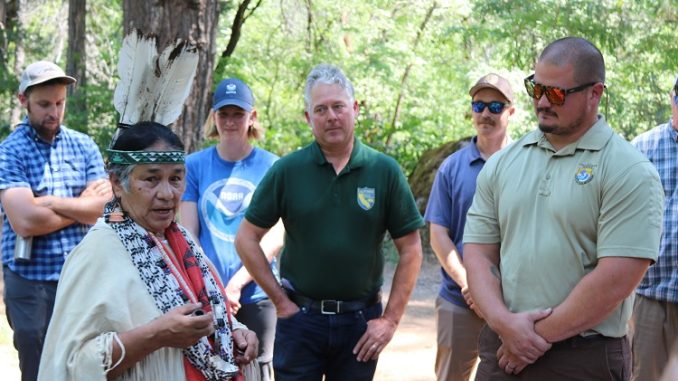
For eight decades, winter-run Chinook salmon were absent from the Winnemem Waywaket, or McCloud River, since Shasta Dam was completed in the 1940s. The dam inundated the cultural sites of the Winnemem Wintu Tribe and prevented the salmon from reaching their headwaters to spawn as they’ve done since time immemorial.
But on July 11, the tribe, the California Department of Fish and Wildlife, the National Oceanic and Atmospheric Administration Fisheries and the U.S. Fish and Wildlife Service (USFWS) celebrated the return of endangered winter-run Chinook salmon eggs to the cold, glacial-fed waters of the McCloud River for the first time in 80 years. The events took place upstream from Shasta Dam.
The tribe and agency staff worked together on installing a Remote Incubation System, or RIS, into which staff from Livingston Stone Fish Hatchery—assisted by Winnemem and other children—gently placed 20,000 winter run eyed salmon eggs back into the McCloud.
During a ceremony, Winnemem Wintu women and girls carried the eggs around the sacred fire to offer them their best chance at surviving in the McCloud. The Tribe sang their “H’up Chonas” song, affirming its commitment to fight and struggle for their salmon, as the women and girls handled the eggs.
“We are asking that the river receive these eggs,” said Winnemem Wintu Chief and Spiritual Leader Caleen Sisk, in explaining the native words, songs and ceremony. “We are asking that the old-time ways continue and that they grow in that way. We put down that song so they have a fighting chance.”
She added, “Our prayer here goes along with the Run4Salmon we’ve been doing for salmon for seven years. That prayer came down from the mountain for us to wake people up and bring them back on the trail for the salmon return. Because they’re ultimately responsible for the conditions of our waters.”
Chief Sisk emphasized the key role that the salmon play in bringing nutrients from the ocean to the river and mountain ecosystem.
“They’re the only ones that bring the nutrients from the ocean up to these mountains, up to these bears, eagles, wolves and coyotes and everything that lived including the people that were here,” Sisk observed. “They all do their jobs. They all die after they spawn. And if we didn’t do our jobs here, there would be a river of dead fish. And we all work together in that cycle of life.”
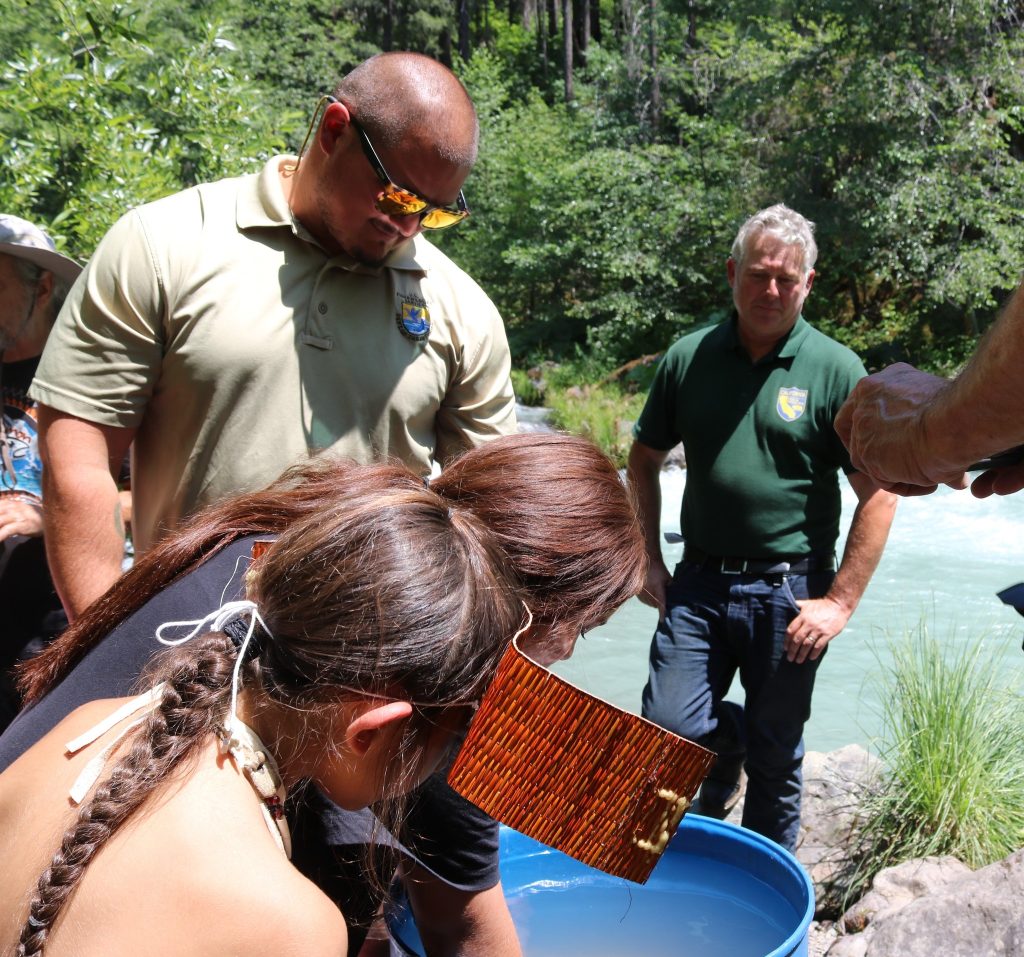
A video of the ceremony is available here: https://youtu.be/Y0tgIlkQlkw
After the developing fry have dropped their egg sacs, they will swim out of the incubator into the McCloud River to begin their journey downriver. Because of turbidity from glacial runoff, the incubation system had to be changed to a tray-based system so the eggs could be kept free of silt.
After collecting the fertilized winter-run eggs from USFWS’ Livingston Stone National Fish Hatchery, the agency staff drove them by truck more than three hours over 80 miles to the Ah-Di-Na Campground within the Shasta-Trinity National Forest on the banks of the McCloud. The release site once held a village where the tribe lived for thousands of years.
While the eggs were transported to the site via an Igloo cooler, the Winnemem Wintu had wanted them to be delivered by helicopter—and want future deliveries of eggs to be delivered by helicopter so the eggs aren’t shaken and disturbed on the rough and rocky road to the site.
On Aug. 8, another 20,000 eggs will be delivered—this time by helicopter—to the McCloud. Both cohorts are being released into the river as fry. After consuming their egg sacs, the fry will swim to the surface of the water, fill up their swim bladders with oxygen, and begin to feed.
“The salmon haven’t been above the dam since the dam was installed and today is a historic moment for salmon,” said Niria Alicia Garcia, Run for Salmon organizer. “Because salmon are going to be dropped for the first time in over 80 years. And it is important that we receive them in a good way so we are here to pray for them. We’re here for ceremony for them. We know it’s not ideal, it’s not New Zealand salmon yet, but it’s a step in the right direction.”
According to the Tribe, this event is one step in the journey that was launched in 2010, when Winnemem tribal members went to Aotearoa in New Zealand to sing and dance for their salmon relatives that have been waiting for 100 years to return to their home waters.
Over 100 years ago, winter Chinook eggs were shipped from the federal fish hatchery on the McCloud River to the Rakaira and other rivers in New Zealand. Those fish, the original strain of winter run fish, now thriving in those rivers, have been extirpated from the McCloud River above Shasta Dam. The Ngāii Tahu Māori Narion and the New Zealand government have both volunteered to return the original strain of winter-run Chinook salmon to the McCloud River.
Now listed under the state and federal Endangered Species Acts, the winter Chinook is a run of salmon found only in the McCloud and Sacramento River watershed that ascends the river from mid-December to March. They are one of four runs of salmon that once flourished in the millions in the Sacramento River, McCloud River and their tributaries.
However, the Gold Rush and the genocide of California Indians, the building of Shasta and other dams, water diversions on the Sacramento River and massive water exports from the Delta to agribusiness in Southern California, have all driven the natural runs of salmon to the edge of extinction.
In 2021, only an estimated 2.6 percent of juvenile winter Chinook salmon survived because of low, warm water conditions below Keswick Dam, according to state scientists.
Agencies and Winnemem agree to co-management
In a breakthrough for the tribe, state and federal agencies have agreed to co-management regarding restoring winter run Chinook on the MCloud River in three key ways, according to Chief Sisk.
First, they agreed to the current emergency phase of putting winter-run Chinook salmon back into the river. “They have to do it with some of our traditional ecological knowledge—not just doing with all their science,” Sisk noted.
Second, they will help the Winnemem transport eggs from New Zealand, where they are now thriving in the Rakaira and other rivers, to California, for reintroduction to the McCloud River, regardless of the results of this current winter run project.
Third, they will provide funding for a volitional passage study within five years to get the fish back to the McCloud River from the ocean. This will include money for pathogen testing on the New Zealand salmon.
It will take two years for eggs to be tested across the ocean until they’re sent back for reintroduction in a tribe-to-tribe agreement with the Maori Nation.
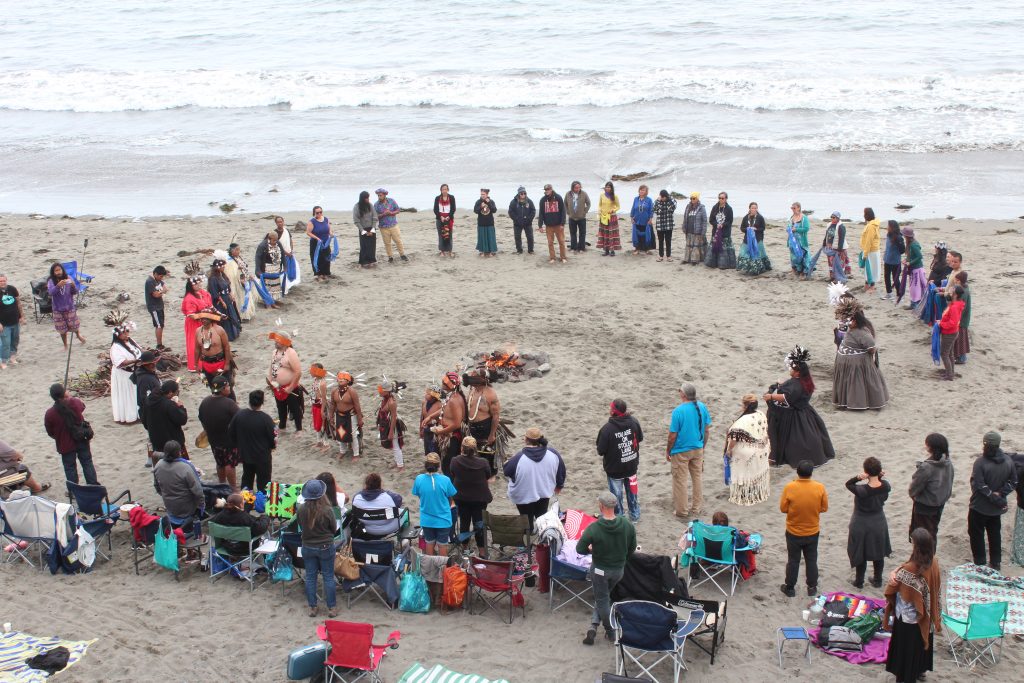
The Winnemem Wintu envision constructing a fishway connecting Dry Creek, which flows into Shasta Lake now, and Cow Creek, that flows into the Sacramento River, so the adult fish can make it upriver to spawn and the juvenile fish can make the long journey from the mountains to the ocean.
“The agencies seem pretty agreeable that things need to change,” said Sisk. “They are saying we need to get the fish upriver, to let the fish go where they are supposed to go. However, we still have battles with what’s going to happen with the raising of Shasta Dam (the Trump biological opinion is still in force); the Bollibokka land sale to Westlands Water District of 8 miles of the McCloud River; and PG&E opposition to restoring salmon to the river in the FERC relicensing of McCloud Dam. We would like them to release more water down the McCloud River for fish.”
Ironically, Sisk said Westlands has been supportive of this reintroduction project, one of the few landowners that have been.
State and federal agency leaders say the historic return of winter-run Chinook salmon eggs to the mountains upstream of Shasta Reservoir is an “urgent response to reduce the extinction risk during a third year of severe drought. It is not a species reintroduction program.”
“The drought action, however, is expected to inform future long-term recovery and reintroduction efforts as biologists learn how the species uses its historical habitat,” according to a statement from California Fish & Wildlife. “Once the eggs hatch later this summer, salmon fry will swim into the McCloud River for the first time since construction of Shasta Dam in the 1940s blocked the migration of adult salmon back to these same mountain waters.”
The agency said rotary screw traps in the river will collect the salmon fry, which will then be transported downstream of Shasta Dam and released to the Sacramento River to migrate to the Pacific Ocean.
State scientists and tribal representatives will camp alongside the incubators and monitor the eggs and the young salmon as they develop and disperse into the river over the next few months.
“While we have carried out a number of different actions to see this iconic species through another year of drought, there’s no denying that Monday’s work just feels huge,” said state Fish and Wildlife Director Charlton H. Bonham. “It’s historic and healing and incredibly hopeful for the future. We are so grateful for the wisdom and guidance the Winnemem Wintu Tribe provided about their ancestral lands and waters, which helped shape this effort.”

Scott Rumsey, acting regional administrator for NOAA Fisheries’ West Coast Region, added, “Given the drought and the harsh reality of climate change, these endangered fish face the longest odds they ever have. The Winnemem Wintu Tribe has long sought to return them to the McCloud. This crucial collaboration with the tribe, state, and other agencies, now reflects more support for the species than ever before and is finally taking an important step toward making that happen.”
Paul Souza, director of the federal Fish & Wildlife’s Pacific Southwest Region, shared his own thoughts, saying, “We know the impacts of drought can have devastating impacts on some of our most precious aquatic species, but it is heartening to know that when we come together with our partners, we are capable of quickly accomplishing lifesaving measures like this for winter-run Chinook.”
The release of the eggs into the McCloud River took place as the Winnemem Wintu Tribe, along with a collective of Indigenous women, activists, and conservationists embarked for the seventh year on the Run4Salmon 300-mile Prayer Journey to restore salmon to the Mount Shasta area. Led by Chief Sisk, Run4Salmon is a ceremonial way of restoring salmon to their ancestral home waters.
The journey of 300 miles starts on Mount Shasta and ends at the shores of the Pacific Ocean in Marin County. The run follows the path of what was once a ‘salmon run,’ from the spawning beds on the upper McCloud River, down the Sacramento River, through the Sacramento-San Joaquin River Delta, and into San Francisco Bay.
Run4Salmon is carried out over three-and-a-half weeks in July by paddling, boating, biking, walking, horseback riding, running, and dancing. The journey now includes tributary runs with the participation of the other tribes, including the Hoopa and Yurok tribes on the Trinity and Klamath rivers and Pomo and other tribes in the Cache Creek and Putah Creek watersheds.
Run4Salmon was named a UNESCO Green Citizen Project this past year, and it is also internationally recognized by the United Nations as a viable indigenous-led solution to the multitude of climate challenges California is facing.
“The Run4Salmon is a prayer journey that comes from salmon to wake people up: If the salmon don’t survive, the Winnemem don’t survive,” explained Sisk. “Water and salmon are now treated as commodities. But the river needs the salmon because the salmon are like the maintenance crew that come from the bottom of the river to clean the river bed so it continues to be good water. The salmon have a specific job and the river needs salmon. The river has a problem now because there’s not enough salmon doing their job spawning in the river.”
She also stressed, “We have to convince this state to be a salmon state. We have the capacity to become a salmon state and to feed the world. If we were a salmon state, we could be like New Zealand exporting salmon. We should be a salmon state instead of a GMO food state. It’s a crazy idea that Big Ag corporations get 80 percent of the developed water in California and only contribute 2 percent to the state’s economy. They’re not the reason why the state is the fifth largest economy in the world.”
Sisk noted that all of the runs of Chinook salmon on the McCloud, Sacramento and other rivers need to be saved and restored.

“The river needs all runs of the salmon. It is not just enough to save the winter run,” she warned. “These salmon have to run because of what they do for the river in different seasons of the year. Elders used to say there were four runs of salmon—spring, fall, summer and winter—they didn’t recognize the late fall run like the state and federal governments do now.”
The endangered Chinook are particularly important among California’s salmon runs because they exhibit a life-history strategy found nowhere else on the West Coast, according to the USFWS. These salmon are unique in that they spawn during the summer months when air temperatures usually approach their warmest.
For the Winnemem Wintu, restoring the salmon is a matter of survival.
“Whatever happens to the fish, happens to us,” Sisk emphasized again. “If the fish don’t survive … there still may be some who claim to be Winnemem, but they won’t be the ones to do the dances and ceremonies and take the sacred medicine.”
Sisk’s son, Michael “Pom” Preston, is an artist and film director. He agrees with the chief’s view.
“We’ve been working on this for a long time,” he said, “and it shows us the power of prayer.”

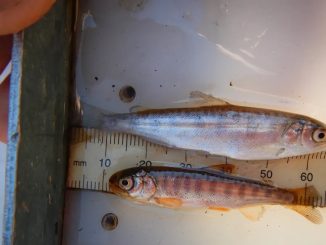

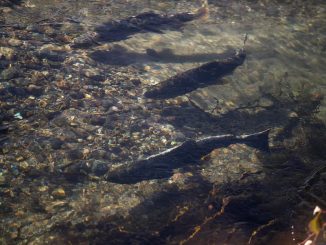
This story makes my heart sing! Chico has been a stop on the Run4Salmon yearly journey. Several Chicoans have helped make it happen, and many of us have attended beautiful events raising money to fuel the vision. It seemed to me a beautiful but impossible dream, and now government agencies are partnering respectufully with the Winnemem Wintu to make this a reality. Gratitude to Chief Caleen Sisk for your fierce determination, and to Chico’s Ron Toppi for your hard work and dedication to make this vision a reality!
This is so inspiring, and really shows what can be accomplished through determination, collaboration, and unrelenting hope. Congratulations to the tribe and all who have participated in this beautiful effort. We look forward to the arrival of the salmon from New Zealand.